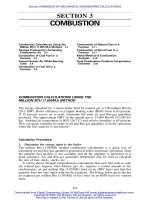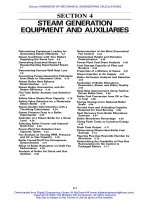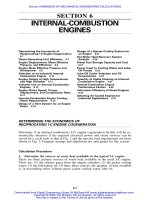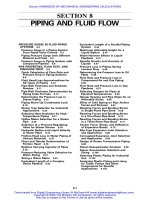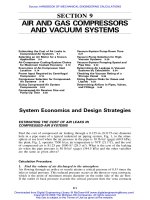Tài liệu HANDBOOK OF BIOENERGY ECONOMICS AND POLICY pdf
Bạn đang xem bản rút gọn của tài liệu. Xem và tải ngay bản đầy đủ của tài liệu tại đây (11.28 MB, 435 trang )
HANDBOOK OF BIOENERGY
ECONOMICS AND POLICY
For other titles published in this series, go to
www.springer.com/series/6360
NATURAL RESOURCE MANAGEMENT AND POLICY
Editors:
David Zilberman
Department of Agricultural and Resource Economics
University of California, Berkeley
Berkeley, CA 94720
Renan Goetz
Department of Economics
University of Girona, Spain
Alberto Garrido
Department of Agricultural Economics and Social Sciences
E.T.S. Ingenieros Agrónomos, Madrid, Spain
EDITORIAL STATEMENT
There is a growing awareness to the role that natural resources such as water, land,
forests and environmental amenities play in our lives. There are many competing uses for
natural resources, and society is challenged to manage them for improving social well
being. Furthermore, there may be dire consequences to natural resources mismanagement.
Renewable resources such as water, land and the environment are linked, and decisions made
with regard to one may affect the others. Policy and management of natural resources now
require interdisciplinary approach including natural and social sciences to correctly address
our society preferences.
This series provides a collection of works containing most recent findings on economics,
management and policy of renewable biological resources such as water, land, crop protec-
tion, sustainable agriculture, technology, and environmental health. It incorporates modem
thinking and techniques of economics and management, Books in this series will incorpo-
rate knowledge and models of natural phenomena with economics and managerial decision
frameworks to assess alternative options for managing natural resources and environment.
The Series Editors
HANDBOOK OF BIOENERGY
ECONOMICS AND POLICY
MADHU KHANNA
University of Illinois, Urbana-Champaign, USA
JÜRGEN SCHEFFRAN
University of Illinois, Urbana-Champaign, USA
DAVID ZILBERMAN
University of California, Berkeley, USA
123
Editors
Madhu Khanna
Department of Agricultural and Consumer
Economics
University of Illinois
Urbana-Champaign
1301 W. Gregory Dr.
Urbana IL 61801
301A Mumford Hall
USA
David Zilberman
Department of Agricultural and Resource
Economics
College of Natural Resources
University of California
Berkeley
206 Giannini Hall
Berkeley CA 94720-3310
USA
Jürgen Scheffran
ACDIS, CABER
University of Illinois
Urbana-Champaign
505 East Armory Ave.
Champaign IL 61820
USA
Insitute for Geography
Hamburg University
ZMAW, Bundesstr. 53
20146 Hamburg
Germany
ISBN 978-1-4419-0368-6 e-ISBN 978-1-4419-0369-3
DOI 10.1007/978-1-4419-0369-3
Springer New York Dordrecht Heidelberg London
Library of Congress Control Number: 2009936725
© Springer Science+Business Media, LLC 2010
All rights reserved. This work may not be translated or copied in whole or in part without the written
permission of the publisher (Springer Science+Business Media, LLC, 233 Spring Street, New York,
NY 10013, USA), except for brief excerpts in connection with reviews or scholarly analysis. Use in
connection with any form of information storage and retrieval, electronic adaptation, computer software,
or by similar or dissimilar methodology now known or hereafter developed is forbidden.
The use in this publication of trade names, trademarks, service marks, and similar terms, even if they are
not identified as such, is not to be taken as an expression of opinion as to whether or not they are subject
to proprietary rights.
Printed on acid-free paper
Springer is part of Springer Science+Business Media (www.springer.com)
Acknowledgments
This volume grew out of two conferences held in 2007 to address the opportunities
and challenges of transition t o a bio-economy. The first, an international sympo-
sium on “Fueling Change with Renewable Energy,” was held at the University
of Illinois at Urbana-Champaign in April 2007, while the second, “Intersection
of Energy and Agriculture: Implications of Biofuels and the Search for a Fuel of
the Future,” was held at the University of California at Berkeley in October 2007.
We gratefully acknowledge financial support provided by the Energy Biosciences
Institute, University of California at Berkeley; Giannini Foundation of Agricultural
Economics, University of California; the Environmental Council, University of
Illinois at Urbana-Champaign; the Farm Foundation; and the Economics Research
Service of the USDA. We thank the Program in Arms Control, Disarmament and
International Security (ACDIS), the Center for Advanced BioEnergy Research
(CABER), and the Department of Agricultural and Consumer Economics at the
University of Illinois at Urbana-Champaign for their support. We also thank the
reviewers of the chapters in this book for their thoughtful comments that helped
to improve the book. Finally, our thanks go to Becky Heid and Amor Nolan for
editorial assistance.
v
Contents
Part I Introduction
1 Bioenergy Economics and Policy: Introduction and Overview 3
Madhu Khanna, Jürgen Scheffran, and David Zilberman
2 Are Biofuels the Best Use of Sunlight? 15
Gerald C. Nelson
3 Perennial Grasses as Second-Generation Sustainable
Feedstocks Without Conflict with Food Production 27
Frank G. Dohleman, Emily A. Heaton, and Stephen P. Long
4 Present and Future Possibilities for the Deconstruction
and Utilization of Lignocellulosic Biomass 39
Hans P. Blaschek, Thaddeus Ezeji, and Nathan D. Price
Part II Interactions Between Biofuels, Agricultural
Markets and Trade
5 Price Transmission in the US Ethanol Market 55
Teresa Serra, David Zilberman, José M. Gil, and
Barry K. Goodwin
6 Biofuels and Agricultural Growth: Challenges
for Developing Agricultural Economies and Opportunities
for Investment 73
Siwa Msangi, Mandy Ewing, and Mark Rosegrant
7 Prospects for Ethanol and Biodiesel, 2008 to 2017
and Impacts on Agriculture and Food 91
John (Jake) Ferris and Satish Joshi
8 The Global Bioenergy Expansion: How Large Are
the Food–Fuel Trade-Offs? 113
Jacinto F. Fabiosa, John C. Beghin, Fengxia Dong,
Amani Elobeid, Simla Tokgoz, and Tun-Hsiang Yu
vii
viii Contents
9 Demand Behavior and Commodity Price Volatility Under
Evolving Biofuel Markets and Policies 133
Seth Meyer and Wyatt Thompson
Part III Designing the Infrastructure for Biofuels
10 Optimizing the Biofuels Infrastructure: Transportation
Networks and Biorefinery Locations in Illinois 151
Seungmo Kang, Hayri Önal, Yanfeng Ouyang,
Jürgen Scheffran, and Ü. Deniz Tursun
11 The Capital Efficiency Challenge of Bioenergy Models:
The Case of Flex Mills in Brazil 175
Peter Goldsmith, Renato Rasmussen, Guilherme Signorini,
Joao Martines, and Carolina Guimaraes
Part IV Environmental Effects of Biofuels and Biofuel Policies
12 Could Bioenergy Be Used to Harvest the Greenhouse: An
Economic Investigation of Bioenergy and Climate Change? 195
Bruce A. McCarl, Thein Maung, and Kenneth R. Szulczyk
13 A Simple Framework for Regulation of Biofuels 219
Deepak Rajagopal, Gal Hochman, and David Zilberman
14 Market and Social Welfare Effects of the Renewable
Fuels Standard 233
Amy W. Ando, Madhu Khanna, and Farzad Taheripour
15 US–Brazil Trade in Biofuels: Determinants, Constraints,
and Implications for Trade Policy 251
Christine Lasco and Madhu Khanna
16 Food and Biofuel in a Global Environment 267
Gal Hochman, Steven Sexton, and David Zilberman
17 Meeting Biofuels Targets: Implications for Land Use,
Greenhouse Gas Emissions, and Nitrogen Use in Illinois 287
Madhu Khanna, Hayri Önal, Xiaoguang Chen,
and Haixiao Huang
18 Corn Stover Harvesting: Potential Supply and Water
Quality Implications 307
L.A. Kurkalova, S. Secchi, and P.W. Gassman
Part V Economic Effects of Bioenergy Policies
19 International Trade Patterns and Policy for Ethanol
in the United States 327
Hyunok Lee and Daniel A. Sumner
Contents ix
20 The Welfare Economics of Biofuel Tax Credits and Mandates 347
Harry de Gorter and David R. Just
21 Biofuels, Policy Options, and Their Implications: Analyses
Using Partial and General Equilibrium Approaches 365
Farzad Taheripour and Wallace E. Tyner
22 Welfare and Equity Implications of Commercial Biofuel 385
Fredrich Kahrl and David Roland-Holst
23 European Biofuel Policy: How Far Will Public Support Go? 401
Jean-Christophe Bureau, Hervé Guyomard, Florence Jacquet,
and David Tréguer
24 Conclusions 425
Madhu Khanna
Index 431
Contributors
Amy W. Ando Department of Agricultural and Consumer Economics, University
of Illinois, Urbana-Champaign, IL, USA,
John C. Beghin Department of Economics, Iowa State University, Ames, IA, USA,
Hans P. Blaschek Center for Advanced BioEnergy Research, University of Illinois
Urbana-Champaign, IL, USA,
Jean-Christophe Bureau AgroParisTech, UMR Economie Publique, Paris,
France,
Xiaoguang Chen Department of Agricultural and Consumer Economics, Univer-
sity of Illinois, Urbana-Champaign, IL, USA,
Harry de Gorter Department of Applied Economics and Management, Cornell
University, I thaca, CA, USA,
Frank G. Dohleman University of Illinois, Urbana, IL, USA; Monsanto Company,
St. Louis, MO, USA,
Fengxia Dong Center for Agricultural and Rural Development, Iowa State
University, Ames, IA, USA,
Amani Elobeid Center for Agricultural and Rural Development, Iowa State
University, Ames, IA, USA,
Mandy Ewing International Food Policy Research Institute, Washington, DC,
USA,
Thaddeus Ezeji Department of Animal Sciences and Ohio State Agricultural
Research and Development Center (OARDC), Ohio State University, Wooster,
OH, USA,
Jacinto F. Fabiosa Center for Agricultural and Rural Development, Iowa State
University, Ames, IA, USA,
John (Jake) Ferris Department of Agricultural, Food, And Resource Economics,
Michigan State University, East Lansing, MI, USA,
xi
xii Contributors
P.W. Gassman Center for Agricultural and Rural Development, Iowa State
University, Ames, IA, USA,
José M. Gil Centre de Recerca en Economia i Desenvolupament Agroalimentari
(CREDA-UPC-IRTA), Castelldefels, Spain,
Peter Goldsmith Department of Agricultural and Consumer Economics,
University of Illinois, Urbana-Champaign, IL, USA,
Barry K. Goodwin Department of Agricultural and Resource Economics, North
Carolina State University, Raleigh, NC, USA,
Carolina Guimaraes Escola Superior de Agricultura Luiz de Queiroz, Department
of Economics, Management and Sociology, University of Sao Paulo, Sao Paulo,
Brazil,
Hervé Guyomard INRA, Paris, France,
Emily A. Heaton Department of Agronomy, Iowa State University, IA, USA,
Gal Hochman Department of Agricultural and Resource Economics, University of
California, Berkeley, CA, USA,
Haixiao Huang Energy Biosciences Institute, University of Illinois, Urbana-
Champaign, IL, USA,
Florence Jacquet INRA, UMR Economie Publique, Paris, France,
Satish Joshi Department of Agricultural, Food, And Resource Economics,
Michigan State University, East Lansing, MI, USA,
David R. Just Department of Applied Economics and Management, Cornell
University, Ithaca, CA, USA,
Fredrich Kahrl Department of Agricultural and Resource Economics, University
of California, Berkeley, CA, USA,
Seungmo Kang Energy Biosciences Institute, University of Illinois, Urbana-
Champaign, IL USA,
Madhu Khanna Department of Agricultural and Consumer Economics, University
of Illinois, Urbana-Champaign, IL, USA,
L.A. Kurkalova North Carolina A & T State University, Greenboro, NC, USA,
Christine Lasco Department of Agricultural and Consumer Economics, University
of Illinois, Urbana-Champaign, IL, USA,
Hyunok Lee Department of Agricultural and Resource Economics, University of
California, Berkeley, CA, USA,
Contributors xiii
Stephen P. Long Energy Biosciences Institute, University of Illinois, Urbana-
Champaign, IL, USA,
Joao Martines Escola Superior de Agricultura Luiz de Queiroz, Department of
Economics, Management and Sociology, University of Sao Paulo, Sao Paulo, Brazil,
Thein Maung Department of Agribusiness and Applied Economics, North Dakota
State University, Fargo, ND,
Bruce A. McCarl Department of Agricultural Economics, Texas A&M University,
College Station, TX, USA,
Seth Meyer Food and Agricultural Policy Research Institute (FAPRI), University
of Missouri, Columbia, MO, USA,
Siwa Msangi International Food Policy Research Institute, Washington, DC, USA,
Gerald C. Nelson International Food Policy Research Institute, Washington, DC,
USA,
Hayri Önal Department of Agricultural and Consumer Economics, University of
Illinois, Urbana-Champaign, IL, USA,
Yanfeng Ouyang Department of Civil and Environmental Engineering, University
of Illinois, Urbana-Champaign, IL, USA,
Nathan D. Price Department of Chemical and Biomolecular Engineering,
University of Illinois, Urbana-Champaign, IL, USA,
Deepak Rajagopal Energy and Resources Group, University of California,
Berkeley, CA, USA,
Renato Rasmussen Department of Agricultural and Consumer Economics,
University of Illinois, Urbana-Champaign, IL USA,
David Roland-Holst Department of Agricultural and Resource Economics,
University of California, Berkeley, CA, USA,
Mark Rosegrant International Food Policy Research Institute, Washington,
DC, USA,
Jürgen Scheffran University of Illinois, Urbana-Champaign, IL, USA,
; Hamburg University, Germany,
S. Secchi Southern Illinois University Carbondale, Carbondale, IL, USA,
Teresa Serra Centre de Recerca en Economia i Desenvolupament Agroalimentari
(CREDA-UPC-IRTA), Parc Mediterrani de la Tecnologia, Edifici ESAB, C/ Esteve
Terrades 8, 08860 Castelldefels, Spain,
xiv Contributors
Steven Sexton Department of Agricultural and Resource Economics, University of
California, Berkeley, CA, USA,
Guilherme Signorini Escola Superior de Agricultura Luiz de Queiroz, Department
of Economics, Management and Sociology, University of Sao Paulo, Sao Paulo,
Brazil,
Daniel A. Sumner Department of Agricultural and Resource Economics,
University of California, Berkeley, CA, USA,
Kenneth R. Szulczyk Department of Economics, Suleyman Demirel University,
Almaty, Kazakhstan,
Farzad Taheripour Department of Agricultural Economics, Purdue University,
West Lafayette, IN, USA,
Wyatt Thompson Food and Agricultural Policy Research Institute (FAPRI),
University of Missouri, Columbia, MO, USA,
Simla Tokgoz International Food Policy Research Institute, Washington DC USA,
David Tréguer INRA, UMR Economie Publique, F-75005 Paris, France,
Deniz Ü. Tursun Department of Civil and Environmental Engineering, University
of Illinois, Urbana-Champaign, IL USA,
Wallace E. Tyner Department of Agricultural Economics, Purdue University, West
Lafayette, IN, USA,
Tun-Hsiang Yu Department of Agricultural Economics, University of Tennessee,
Knoxville, TN, USA,
David Zilberman Department of Agricultural and Resource Economics, University
of California, Berkeley, CA, USA,
Part I
Introduction
Chapter 1
Bioenergy Economics and Policy: Introduction
and Overview
Madhu Khanna, Jürgen Scheffran, and David Zilberman
Concerns about energy security, high oil prices, declining oil reserves, and global
climate change are fuelling a shift towards bioenergy as a renewable alternative to
fossil fuels. Public policies and private investments around the globe are aiming to
increase national capacities to produce biofuels. A key constraint to the expansion
of biofuel production is the limited amount of land available to meet the needs for
fuel, feed, and food in the coming decades. Large-scale biofuel production raises
concerns about food versus fuel trade-offs, demands for natural resources such
as water, and its potential impacts on environmental quality. Policies to support
biofuel production have distributional implications for consumers and producers,
farm and nonfarm sectors, global trade in food and biofuels, and the price of land
and other scarce resources. Moreover, the potential to gain significant indepen-
dence from foreign oil for most countries, including the United States, by relying
simply on corn as a feedstock for biofuels is limited. This has increased interest
in second-generation, lignocellulosic feedstocks that can increase the energy pro-
ductivity of the land resource. These f eedstocks include crop residues, perennial
grasses, and woody biomass. The competitiveness of cellulosic biofuels and their
land use requirements have implications for the costs of meeting advanced biofuel
mandates in the United States, for the land diverted from food to fuel production,
and for food prices. Chapters in this handbook use economic modeling tools to
provide insights into these issues.
The introductory part of this handbook provides a context for the emerging eco-
nomic and policy challenges related to bioenergy and the motivations for biofuels
as an energy source. It includes chapters that explain the current state of knowl-
edge about second-generation feedstocks for advanced biofuels and the technology
for the deconstruction and conversion of lignocellulosic biomass to fuel. Part II of
the handbook includes chapters that examine the implications of expanded produc-
tion of first-generation biofuels for the allocation of land between food and fuel,
M. Khanna (B)
Department of Agricultural and Consumer Economics, University of Illinois, Urbana-Champaign,
IL, USA
e-mail:
3
M. Khanna et al. (eds.), Handbook of Bioenergy Economics and Policy,
Natural Resource Management and Policy 33, DOI 10.1007/978-1-4419-0369-3_1,
C
Springer Science+Business Media, LLC 2010
4 M. Khanna et al.
for food/feed prices for and trade in biofuels as well as the potential for technology
improvements to mitigate the food versus fuel competition for land. These chap-
ters discuss the implications of a growing biofuel industry for agricultural markets,
food prices, and commodity price volatility. Part III examines the infrastructural
and logistical challenges posed by large-scale biofuel production and the factors
that will influence the location of biorefineries and the mix of feedstocks they use.
Part IV includes chapters that examine the environmental implications of biofuels,
their implications for the design of policies, and the unintended environmental con-
sequences of existing biofuel policies. These chapters assess the implications of
biofuels and related policies for greenhouse gas (GHG) mitigation and the chal-
lenges in determining these effects using life cycle analysis. They examine the
trade-offs among different environmental impacts, such as water quality and bio-
diversity, caused by biofuel policies that focus on achieving particular social and
environmental goals. The last part discusses the economic and distributional impli-
cations of existing biofuel policies. These chapters present economic analysis of the
market, social welfare, and distributional effects of biofuel policies, including tax
credits, tariffs, and mandates such as the Renewable Fuel Standard (RFS) in the
United States. The differences in the distributional effects of the emerging biofuel
industry across developed and developing countries are explored.
This handbook is of value for various groups in academia, education, industry,
and governmental and nongovernmental organizations. It is also a useful reference
book for analysts in developed and developing countries working on the socio-
economic impacts of the emerging bioeconomy as well as its implications for land
use, carbon emissions, natural resources, energy, and food prices. This handbook
will also help practitioners and managers in industry and agriculture to deepen
their understanding about theoretical and practical issues associated with imple-
mentation and use of bioenergy and economic and policy dimensions of a growing
bioeconomy.
Interest in the topics presented in this handbook is strong among policy mak-
ers both in the developed and developing world and in international organizations
such as The World Bank and various United Nations agencies. Policy makers will
find useful insights on the economic consequences of various policy alternatives to
support biofuel production. Another major group that will benefit from this hand-
book consists of scholars in agriculture, trade, economic development, resource
economics, and public policy that are interested in issues of renewable energy pol-
icy. They will appreciate the international dimensions presented in this handbook,
in particular issues of trade and the interaction between developed and developing
nations.
While several chapters rely on economic models, we have sought to maintain a
standard of accessibility for a wider audience by de-emphasizing technical content
and expert jargon and emphasizing conceptual, applied, and policy issues that are
of great interest for society. As a r esult, this handbook can be used as a textbook for
courses and curricula associated with the emerging field of bioenergy economics.
As universities develop more specialized curriculum centered around bioenergy,
this book will serve as a reading to familiarize students with applications of
1 Bioenergy Economics and Policy 5
economic tools to analyze the economic and environmental implications of bioen-
ergy development and policies.
This handbook provides an integrated and comprehensive perspective on eco-
nomics and policies related to biofuels. It covers a breadth of issues related to
economic and policy analysis at local, regional, and global levels including crop
and feedstock choices, transportation and infrastructure, processing and produc-
tion, markets and trade, as well as societal implications (welfare effects, agriculture,
food), and environmental impacts (climate change, land use). This handbook spec-
ifies these issues for selected regions of the world (United States, Europe, and
Brazil), which are likely to be important players in the biofuel arena in the near
to medium term.
1.1 Next-Generation Energy Technologies:
Options and Possibilities
Nelson examines whether biofuels are the best use of sunlight for generating energy
usable by humans. Biofuels are produced from plants that capture energy from
the sun through photosynthesis and convert it to starch, sugar, and cellulose that
can then be converted to liquid fuels. An alternative way to use solar energy is
to convert it to electricity using photovoltaic technology. Plants are typically able
to capture less than 5% of the solar radiation intercepted with perennials, such as
Miscanthus, having higher radiation use efficiency. Even conservative estimates sug-
gest that photovoltaics can generate about twice as many kilowatt-hours per square
meter as miscanthus and about three times more than current corn to ethanol tech-
nologies. However, the use of photovoltaics for providing energy for transportation
requires the development of cost-effective engine and battery technologies that have
the power, longevity, and safety needed for automotive applications.
Dohleman, Heaton, and Long discuss the potential of perennial grasses as
second-generation feedstocks that increase the productivity of land in producing
biofuels without compromising environmental sustainability. As compared to corn
ethanol, which requires large nitrogen inputs and has debatable potential to reduce
GHG emissions, low-input high-diversity systems, such as restored mixed-prairies,
have the benefit of requiring low inputs. The productivity of these systems, how-
ever, appears too low to make them economically viable. High-yielding perennial
grass species, such as miscanthus and switchgrass, have many features that make
them “ideal” feedstocks. They are relatively high-yielding, have a high-energy out-
put to input ratio, high nitrogen and water use efficiency and can be grown on
marginal land with conventional farm equipment. This chapter explores the fea-
tures of dedicated energy crops that, if managed properly, will allow integration
of biofuel production into existing agricultural systems with a reduced impact on
food production compared to grain-based biofuels. Expected breakthroughs in cel-
lulosic biomass production, deconstruction, and conversion to liquid fuels will help
accomplish these goals.
6 M. Khanna et al.
Blaschek, Ezeji, and Price provide an introduction into present and future pos-
sibilities for the deconstruction and utilization of lignocellulosic biomass, the
most abundant renewable energy resource on the planet. The “Billion Ton Study”
published by the U.S. Department of Energy (DOE) in 2005 indicated that 1.3 bil-
lion dry tons of biomass (including agricultural residues, municipal paper wastes,
dedicated energy crops) i s available per year in the United States, enough to pro-
duce biofuels to meet more than one-third of the country’s current demand for
transportation fuels. The status of current deconstruction technologies for lignocel-
lulosic biomass and the role of genomics for producing feedstocks and tailor-made
microbes for fermentation-based processes are discussed. This chapter focuses on
the use of biomass-based hydrolysates for the production of bio-butanol, a second-
generation biofuel that can be directly used as a liquid fuel or blended with fossil
fuels. Metabolic engineering and systems biology approaches offer a new toolbox
for the development of microbial strains which are able to grow and ferment in the
presence of inhibitors produced during the deconstruction process, thereby elimi-
nating a major bottleneck in biomass-based fermentations. These new technologies
are expected to play a major role in the successful commercialization of second-
generation biofuels which have an improved energy-carbon footprint and do not
directly compete with food crops.
1.2 Integration Between Energy and Agricultural Markets
Part II of the handbook examines the interactions between biofuels and agricultural
markets and the trade-offs that biofuels pose for food production. As a result of
biofuel production and the resulting integration between energy markets and agri-
cultural markets, energy prices now affect food prices in two ways; directly by
raising the costs of production of agricultural products and indirectly by diverting
land away from food to biofuels. Studies differ in their estimates of the extent to
which biofuel production contributed to the recent increase in food prices; grow-
ing incomes, population, and urbanization coupled with the sharp increase in the
oil price in 2007–2008 and the devaluation of the dollar make it difficult to iso-
late the impact of increasing the share of cropland used for biofuel production on
commodity prices.
Serra et al., Zilberman, Gil et al. use time series data to empirically examine the
linkages among the prices of corn, ethanol, and crude oil. They present a framework
that is based on demand and supply relationships in the corn and fuel markets to
formulate testable hypotheses about the positive relationship between each pair of
the above three prices. They estimate a multivariate vector error correction model
using daily futures prices for corn, ethanol, and crude oil over the 2005–2007 period
and examine the long-run relationships among the variables of the model while
allowing for nonlinear adjustment paths toward long-run equilibrium. They find that
the price of ethanol is positively related to the price of corn and to the price of crude
oil, with changes in corn price having a larger impact on ethanol price than changes
1 Bioenergy Economics and Policy 7
in crude oil price. The implications of this finding for the long-run competitiveness
of the US ethanol industry are discussed.
Msangi, Ewing, and Rosegrant present a simple framework to show the linkages
between energy and agricultural markets, the implications of growth in demand for
energy and food for land use, and the need for technology improvements to increase
the productivity of agricultural crops and to increase fuel conversion efficiencies
which would reduce the need to divert land away from food production to produce
biofuels. They examine the impact of the RFS in the United States on global cereal
prices in 2015 and show the extent to which policy-driven investments in agricul-
tural yield growth can mitigate the increase in cereal prices and reduce the need for
expansion in total cultivated area.
Ferris and Joshi also examine the implications of the RFS for ethanol and
biodiesel production in the next decade (2008–2017) and its impacts on produc-
tion and prices of food, fuel, and feed. Their analysis uses an econometric model
(AGMOD) of US agriculture and the international sector encompassing grain and
oilseeds to present a “baseline” scenario and three alternative scenarios to embrace
a wide range of crude oil prices. The authors find that acreage under coarse grains,
wheat, and soybeans will increase in the United States and globally even with pro-
jected higher yields, but that overall expansion of land in the United States will be
dampened somewhat by a reduction in land under hay, silage, and the Conservation
Reserve Program, resulting in a net increase in total crop acreage of only 5%. Global
crop acreage is expected to increase by 12% between 2008 and 2017. The authors
find that under a high oil price scenario, cropland acreage, land prices, and the con-
sumer price index would be much higher than in the baseline. The authors describe
the existing barriers to significant switching of land from conventional crops to
energy crops. Cellulosic conversion technologies continue to face major uncertain-
ties including the uncertainty about the best pathway for conversion of biomass
to ethanol—is it thermochemical or biochemical or a combination of the two? In
addition, problems related to system integration, commercial scale-up, and overall
process optimization remain unresolved. Projected capital requirements for cellu-
losic ethanol plants are much higher than for corn−ethanol dry mills. Significant
new investments will also be necessary for establishing appropriate biomass supply
chains, including harvesting and storage infrastructure.
Fabiosa et al., Beghin, Dong, et al. use the FAPRI model to estimate the impact
of expanding corn ethanol production and consumption in the United States and
other countries on changes in acreage of biofuel feedstock crops and crops that
compete with these feedstocks for land, as well as on consumption of food and
feed globally in 2016–2017. Impact multipliers showing the responsiveness of crop
acreage to ethanol production and consumption indicate that an increase in corn
ethanol production in the United States has its largest impact on corn acreage in the
United States and is accompanied by significant reductions in the acreage under
wheat and soybeans. A simulation of a 100% increase in ethanol production in
the United States shows that it would increase overall crop acreage in the United
States by about 3% and in the world by about 2%, with the magnitude of the effects
being largest in Brazil and South Africa. Another simulation of the land use effects
8 M. Khanna et al.
of a global expansion in ethanol demand shows that it would l argely result in an
expansion of land under sugarcane in Brazil with modest effects on other countries,
in large part due to the availability of land in Brazil. These results have implica-
tions for the magnitude of the indirect land use changes likely to occur with the
expansion of corn ethanol production in the United States and ethanol consumption
in the world.
While a number of studies have examined the influence of biofuels and biofuel
policy on the prices of agricultural commodities, the impact of greater biofuel pro-
duction on commodity price volatility is less understood. Meyer and Thompson
examine how demand behavior and commodity price volatility change under evolv-
ing biofuel markets and policies. Rising or falling oil, natural gas, and other energy
prices cause corresponding changes in production costs, including fertilizer, trans-
portation, and processing costs. In recent years, changes in market conditions,
technology, petroleum prices, and policies for both energy and agriculture brought
about an explosion in feedstock demand. While a change in the ethanol quantity rel-
ative to the base value may have a very small effect on motor fuel prices, movement
in the large motor fuel market will cause large changes in ethanol volumes, changes
so large that the gasoline price will drive the ethanol price. On the other hand, use of
corn for ethanol drives the corn market and creates a link that transmits volatility in
petroleum prices to corn prices. Growing biofuel processing in the United States has
brought about greater integration between energy and agricultural markets and thus
contributed to volatility in agriculture markets. Their analysis suggests that biofuel
use mandates increase corn price volatility if they are binding. Political actors and
market participants must gauge the consequences of this market volatility for farm
income, food security, and biofuel investments.
1.3 Designing the Infrastructure for Biofuels
Increases in biofuel mandates pose enormous challenges to the infrastructure
needed across all stages of the s upply chain − from crop production, feed-
stock harvesting, storage, transportation, and processing to biofuel distribution
and use. The chapter by Kang et al., Onal, Ouyang et al. focuses on the bio-
fuel transportation and distribution network infrastructure needed to meet given
biofuel targets. Building on an optimal land use allocation model for feed-
stock production, a mathematical programming model is introduced to deter-
mine optimal locations and capacities of biorefineries, delivery of bioenergy
crops to biorefineries, and processing and distribution of ethanol and coprod-
ucts. The model aims to minimize the total system costs for transportation
and processing of feedstock, transportation of ethanol from refineries to blend-
ing terminals, shipping ethanol from blending terminals to demand destinations,
capital investment in refineries, and transportation of the coproduct DDGS to
livestock producing areas in a multiyear planning horizon for the period of
2007–2022. Using Illinois as a case study, it lays the ground for future expansion of
1 Bioenergy Economics and Policy 9
the analysis to the Midwest and the United States and the whole supply infrastruc-
ture. Their analysis shows that certain locations may be more suitable for corn and
corn stover-based ethanol plants, while others may be more suitable for producing
ethanol using perennial grasses (miscanthus). The availability of feedstock and loca-
tion of ethanol demand influence the optimal location and capacity of biorefineries.
Cellulosic refineries are expected to be located in central Illinois where much of the
corn stover is produced and in Southern Illinois where miscanthus is expected to be
profitable to produce.
Bioenergy feedstock production based on extensive farming systems may lead to
inefficiency in the use of capital assets when biofuel production systems are spatially
dispersed and involve fuels and feedstocks that have relatively low-energy densities.
In their analysis of the capital efficiency challenge of bioenergy models, Goldsmith
et al. apply the Liquid Fuel Bioenergy Model to ethanol production in Mato Grosso,
Brazil, to demonstrate the key concepts of density and capital intensity that are criti-
cal for the efficient use of capital. This chapter shows that asset utilization improves
by including maize as a complementary feedstock, because it would improve the
spatial, volumetric, and/or gravimetric densities of feedstock for a Mato Grosso flex
mill.
1.4 Environmental Effects of Biofuels and Biofuel Policies
A key motivation for promoting biofuel production is its potential to reduce the envi-
ronmental externalities associated with transportation fuel. The first four chapters in
this part of the handbook examine the potential for biofuels to mitigate GHG emis-
sions and the regulatory framework that needs to be designed to fully account for
the carbon mitigation benefits of biofuels. Two of these chapters also examine the
unintended effects of existing biofuel policies on GHG emissions and social wel-
fare. While biofuels have the potential to mitigate GHG emissions, they can worsen
other externalities associated with expanding the land under biofuel production. The
last three chapters in this part examine the multiple environmental effects associated
with biofuel production and the trade-offs that biofuels pose among these effects.
McCarl, Maung, and Szulczyk discuss the potential for biomass- and food-based
fuels to reduce GHG emissions by providing biopower, biofuels, and soil carbon
sequestration. Their chapter describes the range of options and technologies for
bioenergy and uses the FASOMGHG model to simulate the future production levels
of various types of bioenergy and GHG mitigation under alternative and fossil fuel
and GHG prices. Using life cycle analysis, the model accounts for direct mitiga-
tion by displacing fossil fuels with bioenergy and for leakages due to indirect land
use changes in other parts of the world. When the prices of fossil fuels and GHG
emissions are low, agricultural soil sequestration is the dominant mitigation strat-
egy and as carbon prices increase, production of cellulosic ethanol can be expected
to increase. The chapter considers the implications of carbon taxes for crop prices,
meat prices, and agricultural exports and recommends that biofuel and GHG miti-
gation policies take leakage effects into account. Their analysis suggests that these
10 M. Khanna et al.
leakage effects can be reduced by relying on crop residues and waste products for
cellulosic ethanol and on bio-based electricity.
Rajagopal, Hochman, and Zilberman describe a regulatory framework that could
be developed to regulate the direct and indirect GHG emissions from biofuels, while
incorporating the heterogeneity in biofuel production sources and the uncertainties
that influence production methods and indirect land use changes. While direct GHG
emissions can be computed ex-post using life cycle analysis, indirect GHG emis-
sions need to be computed ex-ante using multimarket or general equilibrium models.
Given this heterogeneity and uncertainty, regulators may pursue a precautionary
approach by designing certification standards that use these estimates to set an upper
bound on emissions from biofuels. Biofuels that seek to qualify for government
subsidies or account toward mandates would need to be certified.
Ando, Khanna, and Taheripour examine the social welfare and environmental
implications of the RFS by developing a framework that considers the demand for
gasoline and ethanol to be derived from demand for vehicle miles traveled (VMT)
and the imperfect substitutability between ethanol and gasoline in producing VMT.
They incorporate the disutilities from VMT (congestion and air pollution) and from
fuel (GHG emissions) and show that an optimal policy includes a tax on carbon and
on VMT. The extent to which a biofuel mandate leads to displacement of gasoline
and reduction in GHG emissions and VMT depends on the elasticity of supply of
gasoline and the elasticity of substitution between gasoline and ethanol. They com-
pare the welfare and environmental effects of a mandate with those of a carbon tax
and find that the former imposes high welfare costs and results in higher miles and
GHG emissions than a carbon tax policy. The magnitude of these effects is sensitive
to the gasoline supply elasticity.
Lasco and Khanna examine the effects of current US biofuel policies for corn
ethanol, namely tax credits and import tariff, for the imports of biofuels, fuel prices,
GHG emissions, and social welfare in the United States. They review the devel-
opment of the sugarcane ethanol industry in Brazil and compare the costs and
life-cycle GHG emissions of corn ethanol in the United States and sugarcane ethanol
in Brazil. They show that current biofuel tariffs lead to welfare losses relative to
no government intervention even if one accounts f or their terms of trade effects
for the United States, assuming that the United States has market power in the
world ethanol market. Moreover, the current tariff and tax credit policy results in
higher GHG emissions as compared to non-intervention because the subsidy induces
greater demand for VMT while the tariff causes a substitution away from the less
carbon-intensive to a more carbon-intensive biofuel.
The nexus between energy and agricultural markets that has been forged by
biofuels has implications for multiple environmental externalities generated by
energy and agricultural production. Hochman, Sexton, and Zilberman examine these
interactions between energy, food, and the environment by developing a general
equilibrium framework in which households obtain utility from food, an environ-
mental amenity, and a convenience good produced using capital and energy. They
examine the trade-offs posed by biofuels as they reduce GHG emissions but increase
1 Bioenergy Economics and Policy 11
demand to convert non-cropland that provides biodiversity services to energy pro-
duction. They show that a carbon tax policy would put additional pressure on natural
habitat unless biodiversity preservation is valued and carbon tax policy is accompa-
nied by a tax on converting natural land to cropland or payments for environmental
services. The chapter also discusses the need to link biofuel policies to food
inventories to ease the food versus fuel trade-off and emphasizes the importance of
innovations that increase crop productivity and that enable conversion of cellulosic
feedstocks into fuel.
Khanna et al., Onal, Chen, et al. examine the competitiveness of second-
generation cellulosic feedstocks and the allocation of land among food and energy
crops for meeting biofuel targets such as those under the RFS at a regional level.
They examine the trade-offs that the RFS poses for reduced GHG emissions but
higher nitrogen use as production of corn ethanol and harvesting of corn stover
increases. Using a dynamic optimization model coupled with a biophysical model
that simulates the yields of dedicated energy crops, switchgrass and miscanthus,
and county-specific data on costs of production of conventional and energy crops,
they show that biofuel targets are likely to lead to a significant shift in acreage from
soybeans and pasture to corn and a shift toward conservation tillage and continuous
corn rotation as demand for corn and corn stover for biofuels increases. The eco-
nomic viability of miscanthus is found to vary spatially depending on its yields per
acre and the opportunity cost of land.
Kurkalova, Secchi, and Gassman assess the environmental implications of the
removal of corn residue for cellulosic biofuels. Crop residues left on the field after
harvest provide several environmental benefits such as soil organic matter, nutri-
ent recycling, control of nutrient runoff, and preventing erosion. The authors use
detailed field-level GIS data together with economic and environmental models to
examine the spatial distribution of corn production, corn residue availability, and
soil and water quality indicators under alternative prices of corn, soybeans, and corn
stover with 50% removal of corn residue. The authors find that as corn stover prices
increase, residue removal increases and so do the sediment and nitrogen losses.
These losses are larger under continuous corn rotations. Soil carbon stocks decrease
as corn stover removal increases and levels are higher with continuous corn rota-
tions than with corn−soybean rotations due to the larger corn biomass compared to
soybeans.
1.5 Economic Effects of Biofuel Policies
Lee and Sumner review the history of biofuel policies in the United States under
various Energy and Farm Bills. The authors discuss conditions under which the US
elasticity of demand for imported ethanol ranges from high elasticity (with a low
share of ethanol in total US fuel use) to low elasticity (under a binding mandate).
Using historical data on ethanol imports and the prices of ethanol, crude oil, and
corn, the authors estimate the elasticity of supply of exports of ethanol from Brazil
12 M. Khanna et al.
to the United States to lie between 2.5 and 3.0. They examine the implications of
these elasticities for removal of the import tariff and argue that it is more likely to
lead to a change in the quantity of imports (of about 68%) and not much change
in the domestic price of ethanol unless imports have a large share and US ethanol
capacity is low.
de Gorter and Just describe the existing biofuel policies in the United States and
the objectives they seek to promote. They show the linkage between ethanol and
gasoline price and analyze the implications of tax credits, mandates, and ban on
MTBE as an additive to gasoline for the relationship between ethanol and gasoline
prices. The chapter also examines the factors leading to a link between ethanol and
corn prices and the social welfare effects of the ethanol subsidy and the loan rate
program for corn. The authors discuss policy reforms that can better achieve the
multiple goals of biofuel policies.
Taheripour and Tyner discuss the contribution of US biofuel policies to the biofu-
els boom since 2005 and the consequences of expansion in the ethanol industry for
the agricultural and energy markets under alternative policy options. Their estimates
of the break-even combinations of corn and ethanol prices that keep a representative
dry mill ethanol plant at zero profit condition show why the ethanol industry’s prof-
its declined after 2006 after t he ethanol premium fell and corn prices rose. Analysis
of the impacts of alternative policies, the tax credit, a variable subsidy, and the corn
ethanol mandate under a range of crude oil prices shows the linkage between crude
oil prices and corn prices, as well as the contribution of the biofuels subsidy to the
price of corn. The costs of these policies to the government (in the case of the sub-
sidy) and the consumers (in the case of the mandate) are examined. The authors then
describe the results of their analysis of the global changes in land use due to bio-
fuel policies in the United States and EU using a general equilibrium model, GTAP.
They show the importance of accounting for biofuel by-products while analyzing
the effects of biofuel policies on agricultural production patterns around the world.
Kahrl and Holst examine the distributional incidence of energy and food price
increase across countries that differ in their per capita income levels, using a vari-
ety of empirical techniques. Their analysis shows the dichotomy in North−South
energy and food dependence. While the share of income spent on food is negatively
related to per capita income, the per capita energy use increases with income. The
authors use various methods to examine the effects of energy and food on house-
hold cost of living and incomes. They estimate the elasticity of the poverty gap
with respect to food and energy prices for various income deciles in Thailand and
Vietnam and show that energy price vulnerability is relatively low in both countries
and much lower than food price dependence. Using the social accounting matrix,
they examine how food and energy price changes are transmitted through the econ-
omy and affect households. An application of this method to Morocco shows that the
total impact of food price increase on t he household consumer price index is much
higher than its direct effect on the food price index alone and that both are relatively
high for the poor. Finally, using a general equilibrium model, the authors explore
both the income and expenditure effects of food price increases for households in
Senegal. They show that high food prices benefit some rural deciles, while they hurt
1 Bioenergy Economics and Policy 13
the urban poor. Their findings have implications for equity effects of biofuel policies
across high- and low-income countries and groups within a country.
Bureau et al., Guyomard, Jacquet, et al. assess European biofuel policy and pub-
lic support for it, which resulted in two biofuel directives in 2003 and led to an
unprecedented growth in biofuel production over the past 5 years. The main driving
force has been the measures taken at the member state level aiming at increasing the
use of biofuels, including tax exemptions, subsidies, and mandatory blending with
transport fuel. This, together with significant import barriers, at least for ethanol,
has led to a considerable increase in domestic production since 2003. Meanwhile,
concerns about the overall environmental and social effects of biofuels, including
the effects of indirect land use changes and potential competition for land with food
production, have triggered intense debates and an erosion in the public image of
biofuels. This has led some member states to review their initial ambitions. The
2008 reform of the Common Agricultural Policy still favors the widespread devel-
opment of biofuels, but ended the subsidies for the production of energy crops. The
new energy policy directives now focus on renewable energy mandates rather than
biofuel blending mandates. This together with the current economic crisis adds to
uncertainty about the future of biofuels in the EU.
1.6 In Sum
This handbook covers a wide range of issues that have emerged with the advent of
biofuels and presents a diverse set of economic models and approaches to analyze
their implications for food and fuel prices, consumers, producers, and the envi-
ronment. It shows that food-based biofuels have led to a competition for land and
integration between energy and agricultural markets, while the environmental ben-
efits of current biofuel policies are ambiguous or even negative. New technologies
that increase crop productivity and fuel-conversion efficiencies and enable the use
of cellulosic feedstocks together with policies targeted at sources of market failures
need to be designed to induce a shift toward biofuels that are economically, socially,
and environmentally sustainable.



